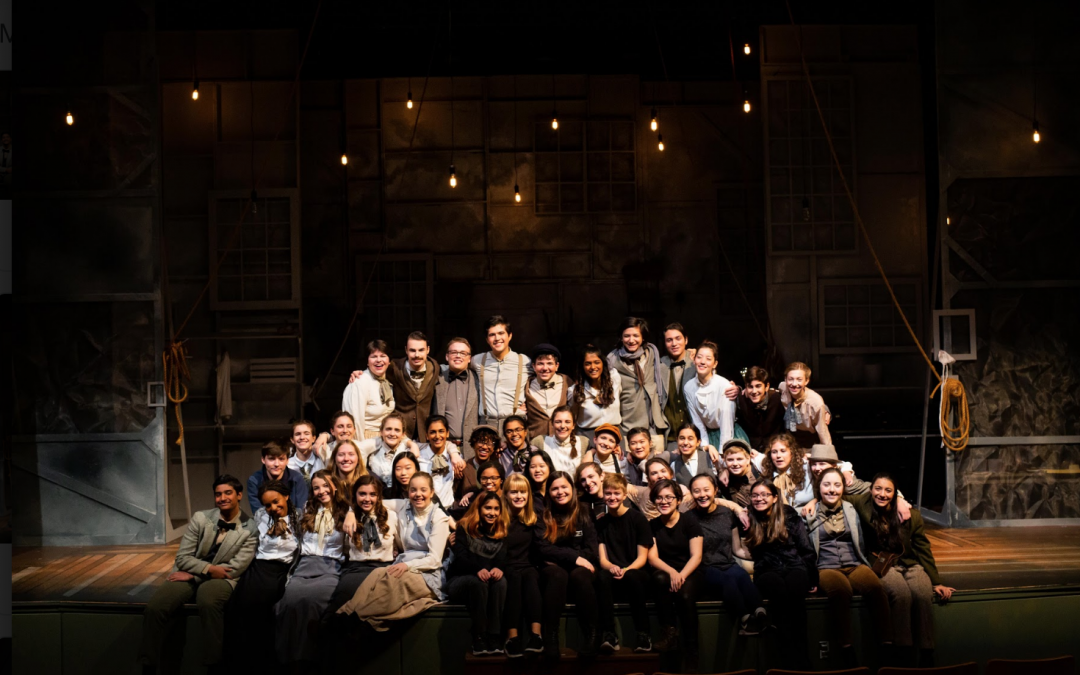
Dec 9, 2019 | School News, Uncategorized
By Ashleigh Provoost (IV)
This year, the Pingry Drama Department performed the play Our Town for its annual fall production, holding performances on November 7th and 9th. Written by Thornton Wilder and directed by Mrs. Stephanie Romankow, the play follows the life of Emily Webb and George Gibbs. These two neighbors experience everything together: growing up, falling in love, and eventually dying. The play is set in a small town called Grover’s Corners in New Hampshire. It explores the seemingly mundane activities in life, and how the small details of the world are what make it worth living. A play within a play, this show is narrated by eight stage managers: Corbey Ellison (VI), Nina Srikanth (VI), Lily Arrom (V), Alex Kaplan (V), Adelaide Lance (V), Sydney Stovall (V), Natalie DeVito (IV), and Ram Doraswamy (VI). As these narrators open and close the show, they leave the audience with a warm feeling of nostalgia, as well as the realization that each moment is instrumental making one’s life unique and beautiful.
Act I begins in Grover’s Corners, as the audience observes a typical morning for the Gibbs’ and Webbs’ families. Mrs. Gibbs (Cal Mahoney, V) tries to stop her children, George (Stuart Clark, VI) and Rebecca (Charlotte Schneider, IV), from fighting. Her husband, Dr. Gibbs (Josh Thau, VI), returns from an early morning call. Meanwhile, Mrs. Webb (Sonia Talarek, VI) makes sure her children, Emily (Helen Baeck-Hubloux, VI) and Wally (Ronan McGurn, III), exhibit good table manners. Their father, Mr. Webb (Jonathan Marsico, V), is at work. Act I allows the audience a glimpse into the daily life of a Grover’s Corners resident.
Act II is centered around George and Emily’s wedding. This includes a flashback of when both characters realized they were meant to be with one another; after a long talk over ice cream sodas in Mr. Morgan’s (Lily Arrom, V) drugstore, they admitted their feelings for one another and decided to get married soon after their high school graduation. The act ends with a captivating wedding celebration.
The play transitions into Act III, which takes the audience through Emily’s sudden death during childbirth. As she joins the world of the dead, she realizes just how much she loved being alive and spending time with family and friends. The audience joins her as she revisits her 12th birthday and reflects on how fast life truly goes by.
The performances were the culmination of two strenuous months of rehearsals and set building, and they showcased the efforts of over 50 students. Along with Mrs. Romankow and head stage manager Lindsay Cheng (VI), new faculty members Mr. Joseph Napolitano and Ms. Emma Barakat were heavily involved in the production. Ms. Baraket played the crucial role of head carpenter. Mr. Napolitano, who was the lead set designer, greatly enjoyed his first Pingry production. He described Our Town as “a true example of collaboration, and the perfect first project for [him] to work on at Pingry.” Reflecting on the past few months, he adds: “Working with the design & tech crew, Mr. Van Antwerp, and Mrs. Romankow was a joy. I believe all of our work blended together in a delightful way.”
Mr. Napolitano was not the only one to note the production crew’s strong sense of community. Adelaide Lance remarked that “[The show] was amazing! We’re truly all one big family.” For some, however, the fall play marked the beginning of the end. Stuart Clark, having completed his final fall play, reminisces about acting at Pingry: “It was all so special. The Drama Department has given me a lot over my four years at Pingry. I’m really grateful that I had the opportunity to act alongside people that mean a lot to me.”
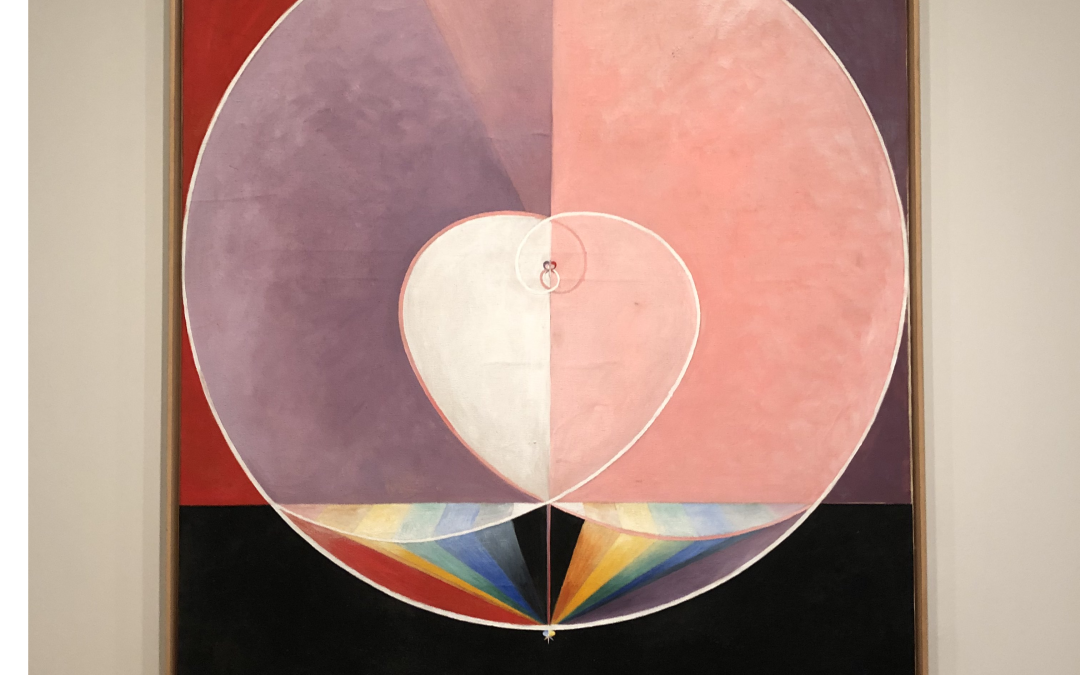
Dec 9, 2019 | Mirika Jambudi, School News
By Mirika Jambudi (III)
On Thursday, November 14th, ninth-graders in Art Fundamentals and various other classes visited the Museum of Modern Art for their annual art trip into New York City. They visited many of the museum’s new exhibitions, including, but not limited to, “Transfigurations,” “Inner and Outerspace,” and “Hardware and Software.” The trip featured many different types of galleries, including ones specializing in photography, digital media, and 3D artwork; each elicited many different reactions from the students. Victoria Ramos (III) said that she “was surprised to see how much art had changed throughout the centuries as [she] walked from gallery to gallery.”
One of the collections that many students seemed to enjoy was Gretchen Bender’s “Dumping Core” exhibit. It featured 13 video monitors in a dark room set to techno music that displayed many intercut logos, graphics, and clips from TV and movies. These images were all pieced together to create an eye-catching visual display. After further research, students later found that the meaning behind this exhibit was to subvert corporate agendas and combat the use of technology for commercial gain.
Another collection was entirely dedicated to the Tiananmen Square student protests in the 1980s. The artists featured in this collection used very abstract methods and techniques to convey their anger at the government, such as lathering a chicken with soap, firing a gun at their artwork, or photographing protestors lighting fireworks in Tiananmen Square. These artworks challenged the overwhelming censorship of the Chinese government and were seen as forms of protest and rebellion. They were also viewed as individualist responses towards reforming socio-economic shifts and urbanization at the time. “It was exciting to learn and research the backstories behind these works of art, because it is more complex than what you see on the surface,” says Caleb Park (III). Zala Bhan (III) also agreed that the trip was a success and a great learning experience because she was “exposed to many different forms of artwork …which really broadened my perspective on what one can define as art.”
After coming back from the art trip, the students were asked to curate their own “gallery” of ten paintings that they found interesting and had a common principle or element of art. They were also asked to analyze different techniques that the artists used in their artwork, such as emphasis through color or movement through shapes, lines, and value. Students had fun selecting and organizing these works of art in their own mini-gallery project; overall, the trip was a fantastic experience.
Dec 9, 2019 | School News
By Kyra Li (III) and Anjola Olawoye (III)
As the annual Winter Festival approaches, Pingry students are preparing for their performance for family and friends on December 12.
The day before, many ensembles, including chorus, band, orchestra, and handbells, will be performing various selections of winter and holiday-themed music for the all-school concert. It is a decades-long tradition, and for some, it is the most memorable event of the school year. It is also the only time of the year when both the Short Hills and Basking Ridge campus come together in one space to celebrate the winter festivities and indicate the beginning of the holiday season.
Last year, the program began with former Headmaster Nat Conrad’s remarks about the holiday season and the importance of giving and sharing commonalities. “It is wonderful and important to share what we have in common and make a good effort to share the gift of friendship,” he said.
As usual, many traditions, like the Presentation of Gifts and the Candle Lighting Ceremony, took place last year and will also appear in this year’s concert. Last year, Student Body President, Andrew Cowen ‘19, assisted Charles Brunhouse ‘31 and Riya Mirchandani ‘31 in lighting the festival candle at the concerts. This year, Student Body President Brian Li ‘20, will assist two new kindergarteners in lighting the candle.
This year’s program starts with Deck the Halls. As always, it will include classic songs, such as Al Hanissim and Maoz Tzur, and will end with the all-school sing-a-long of the Twelve Days of Christmas.
Everyone is looking forward to and preparing for the Winter Concert. Mr. Sean McAnally, one of the music teachers, said that this is his “favorite concert of the year, and it is a wonderful experience where the entire school comes together to celebrate the beginning of holiday festivities.”
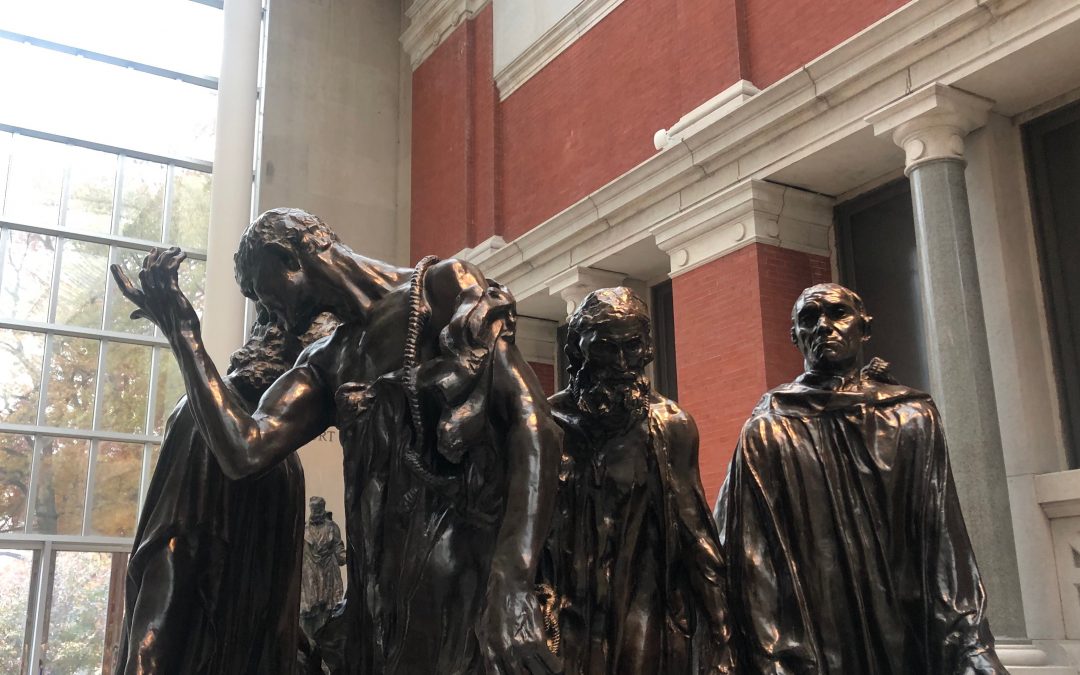
Dec 9, 2019 | School News, School Trips
By Vicky Gu (VI)
On Monday, November 18, the AP Art History class, along with Mr. Nigel Paton and Ms. Paula Fisher, took their annual trip to the Metropolitan Museum of Art in New York City.
Before the trip, students studied the art of people from Africa, Oceania, western North America, and classical antiquity. They saw many works in real-life that they had previously seen only on computer screens.
The field trip started in the Greek and Roman art wing. Students viewed Mediterranean art from various different ancient eras and were able to compare what they had learned in class to the actual sculpture. The Greek, Archaic Marble statue of a kouros, for example, was slightly disproportionate and much more stiff-limbed than the Hellenistic, Roman Marble sarcophagus with the Triumph of Dionysos and the Seasons that was sculpted almost three hundred years later.
The students examined other works that hadn’t been studied in class, such as various Greek vases, Roman bronze sculptures (which often copied or were inspired by Greek sculptures), and frescoes. The Met even had a reconstruction of a room—the fresco walls of Cubiculum (bedroom) from the Villa of P. Fannius Synistor at Boscoreale. These walls were painted with perspective, vivid colors, ornamental details, and give a relatively small area a greater sense of space.
The students had previously been assigned to present various pieces of artwork from Africa and America. A particularly striking artwork was the Nkisi n’kondi, or Power Figure, created by the Kongo people in the late 19th century. Many students were amazed by the intimidating atmosphere and size of the wood sculpture as it stood on its raised pedestal. Carson Shilts (V) and Sandra Adablah (V) presented the work and explained that every time a villager committed a crime or a sin, the citizens would hold a meeting for the sinner to apologize. Nails, shards of glass, and other sharp objects were driven into different parts of the figure’s body depending on the severity and nature of the crime.
Other works presented include bronze plaques of African royalty and Native American elk hides and masks. Students, who had already learned about the ceramic processes of Maria Martínez of the San Ildefonso Pueblo, were able to view her Black-on-Black Jar, which was particularly unique given the use of glossy and matte black surfaces in her designs.
The field trip concluded with an hour of free time to explore the rest of the museum. While some students wandered around to see what other works might interest them, others had already planned to search for specific artists and movements.
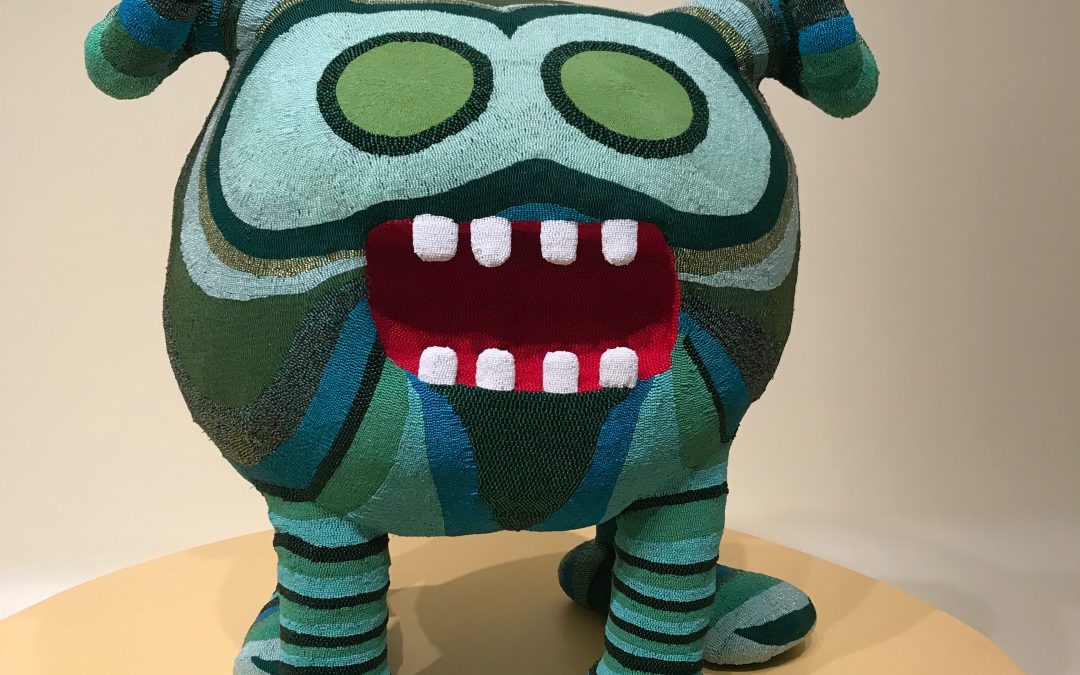
Dec 9, 2019 | School News, School Trips
By Carson Shilts (V)
On October 18, over one hundred students filed into buses and rode to Chelsea, New York. There, with bagels in their hands and earbuds in their ears, students in photography, drawing and painting, and portfolio classes discovered the awe-inspiring artworks exhibited in the Chelsea art galleries.
Chelsea’s galleries display a variety of different types of art. One well-known artist whose work was exhibited is Christian Marclay, who creates abstract art inspired by anime. Marclay is known to embody sound and music in his paintings and videos. Another featured artist was Ed Clark, a highly respected painter who is known for his striking abstract impressionism paintings. The students who went to his gallery were able to appreciate his talent and acknowledge the imprint he has left on the art community. The galleries also displayed works from up and coming artists, achieving a balanced variety of well-known and newer work. From political pieces to vibrant monster sculptures, there was an exhibition for everyone.
Once they arrived, the students were split up based on the classes they are in so they could see all the artwork that was most connected to what they were currently learning. Though this trip was meant to break the boundaries of the types of art that students were accustomed to seeing, an emphasis was placed on art that correlates with their medium. Students were also asked to take nine separate photos: three artworks that inspired them, three artworks they did not understand, and three artworks that they would give to their friend as a gift. This allowed students to analyze the art from different perspectives.
The photography teacher, Mr. Boyd, said that he “wanted students to get a new range of ideas of what kind of art is out there.” He hoped that this would then “create another layer of ideas” that students could bring back to the classroom and incorporate into their own work. Fortunately, his hopes came true. When asked what she learned, Abby Parrish (V), a photography student, said, “Going into the trip I had a closed view of what art is and what art should be. When visiting the galleries, I realized there were many more different types and perspectives of art that I hadn’t even known existed. For example, there was this one gallery that had a kitchen in the back and it was using space as art and I had never thought that art could be portrayed in that way, which I thought was really cool.”
After viewing the galleries, students visited Chelsea Market, escaping the cold to eat lunch and shop for souvenirs. Upon returning to Pingry, participants headed to their classrooms to reflect on what they found most interesting. They also shared the photos they were asked to take. Overall, the trip to the Chelsea Galleries was incredibly successful, and the art students and faculty are excited to go again next year!
Dec 9, 2019 | Brynn Weisholtz, Editorial
By Brynn Weisholtz (VI)
At Pingry, a student’s academic coursework is primarily determined by the administration and follows a fairly regimented path. There is limited flexibility for a student to “choose” any portion of his or her schedule in the early years of high school. This rigidity is seen mostly during the freshman and sophomore years when students are expected to take core classes to meet Pingry’s requirements for graduation. With the exception of a few electives, such as Art Fundamentals or a second language, ninth and tenth grade schedules are overflowing with mandatory classes in math, English, history, science, and foreign language requirements. These packed schedules do not leave much room for signing up for more specialized classes.
While junior year allows for some wiggle room with course selection, there are still mandatory classes, like American Literature and the next math and language classes on a student’s respective track, that eleventh graders must take. The real change occurs senior year when no mandatory classes are required, and the course choices become abundant. For the first time as a Pingry student, I had the ability to select courses I truly wanted to take. AP Gov or AP Euro, Science in the 21st Century or Anatomy and Physiology, Greek Epic or Shakesphere, Spanish 6 or French 1. This was empowering.
Every class I am participating in this year is a class I chose to be in, with subject matter I wanted to explore. While I have always been happy to come to school, eager to share my insight in class, it wasn’t until this year that I felt everything align, allowing my innate curiosity to soar beyond my own expectations. This heightened sense of fulfillment can only be attributed to the personal interest I have in each class I selected. Sitting side-by-side with peers with similar interests, we seem more motivated to engage deeply in the subject matter.
Having the opportunity to finally spend my days studying material that sparks the most interest in me leaves me asking the question: why did it take so long to arrive at this point? Could I have benefited from having more choices earlier in my academic career? What experiences could have further shaped me into me? Rather than lament what could have been, I choose to look ahead and embrace what is and what will be.
That said, I believe it would be beneficial to explore offering additional electives to students starting freshman year as a way to broaden horizons and spark intellectual curiosity, which is inherently one of Pingry’s pillars. Who knows what class will inspire a young mind to thrive intellectually?
Dec 9, 2019 | Editorial, Noah Bergam
By Noah Bergam (V)
When I was a little kid, I got angry when I heard my name. Noah. I heard the word ‘No.’ Somehow that just pushed me over the edge. My older siblings, realizing my dislike, would further taunt me by calling ShopRite ShopWrong. I would cry.
Now it’s more sophisticated. I cry a little inside when I see political arguments and platforms supported fervently in the negative.
Ralph Ellison’s anonymous namesake Invisible Man asked a simple question. “Could politics ever be an expression of love?” The quote reads quickly in the context of the chaotic unfolding of the novel. But when I read it, I stopped and realized this combination of words is powerful.
It comes back to me every month for the Democratic debates. As I’ve watched these candidates give their heartfelt pleads for their causes, I’ve gone through my own little evolution as a viewer.
When I first watched in June, I was amazed by how eloquently they all could speak, swinging from topic to topic with such ease and intensity. Each candidate presented their own style, playing different gambits and spinning sophisticated responses, tying it back to their audience. All on the spot. It blows me away. But … but what? The charm blurred with repetition? The candidates are all a bunch of phonies? Emails!? Perhaps. But the fundamental issue I see is not with any of the specific values they hold or policies they endorse. It’s about a frame of reference. Their tendency to express their stances in terms of the partisan negative rather than the general positive. The tendency is captured by the standby:
“I’m the candidate that can beat Donald Trump.”
There’s a use for this phrase in moderation. But it ought not to become a cornerstone argument of the party—2016 is proof that doesn’t work.
When this mindset of opposition takes over for a few questions, the stage curls into an echo chamber, where counterpoints that lean to the center are labelled as enemy territory.
This was especially evident in the July debate; when Warren and Sanders kept recycling a certain phrase, they were met with opposition.
John Delaney warned against taking away private health insurance. John Hickenlooper objected to the Green New Deal’s broad promises of government-funded jobs. Jake Tapper asked Bernie how much taxes will rise for his healthcare bill.
The same response kept ringing up: “stop using Republican talking points.”
The intent of this phrase, as I see it, is to paint criticism as illegitimate partisan attacks. It’s defense built from offense––take the hard questions, that many voters are interested in getting direct answers to, and mark it as Republican, Trumpian spam.
This attitude has continued monthly. Of course, it doesn’t ruin the entire debate––most major candidates have their shining moments of clarity––but it confuses the very intent of these debates, which is to give the candidates a chance to explain their policies and disagree, so that we viewers can determine their differences and make the most educated vote we can. What is not needed is a constant, propaganda-esque reminder of our unity against those dreaded Republicans!
At the 2016 Democratic National Convention, Michelle Obama famously said, “When they go low, we go high.” Do not weaken the potential of your vote by thinking only in terms of who you are beating out. Vote for a positive, progressive vision of the future, not simply an anti-Trump candidate.
But everyone––this is a lesson that transcends party lines. I don’t know if politics could be an expression of love, but I like to believe that the heavy focus on partisan differences and identity could be relieved. That politics can be less an expression of electability and more an expression of a concrete stance, a vision.
In short, ShopRite instead of ShopWrong.
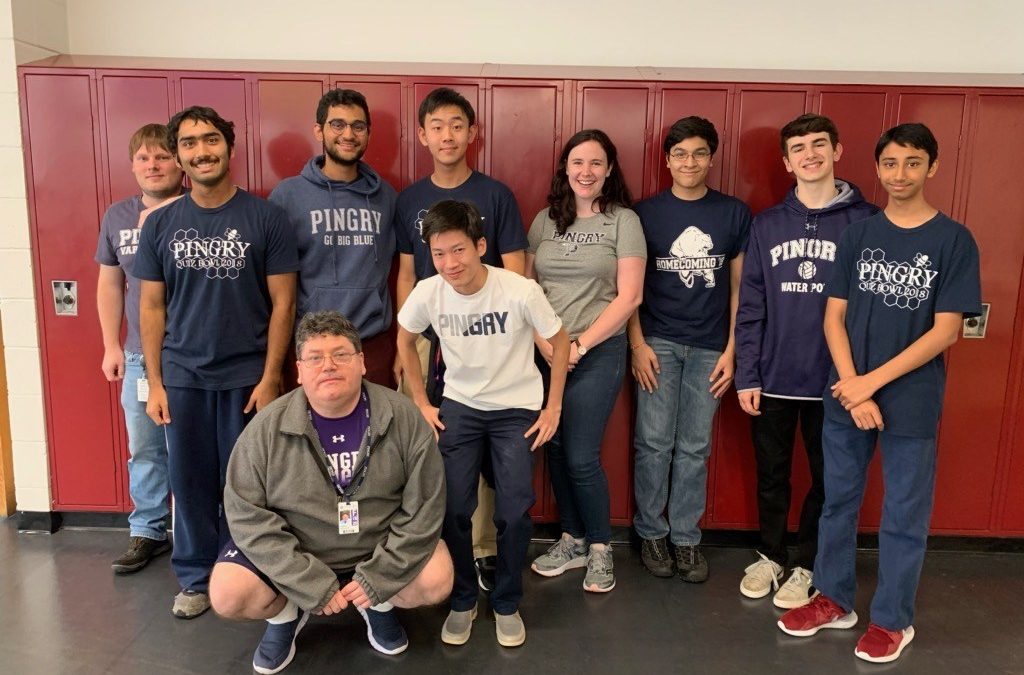
Dec 9, 2019 | School News
By Caleb Park (III)
As I walked into the room, pencil in hand, I felt a rush of adrenaline and perhaps a bit of anxiety. It might have been the moderator’s intense stare, or the energy of my teammates, but pure excitement coursed through my veins. I knew that nothing but mental contest awaited me. This is what it feels like to be part of the Pingry Quiz Bowl Team.
Although some might view Quiz Bowl as glorified “trivia night” or a pastime for “nerds,” both of these labels could not be farther from the truth. The art of Quiz Bowl is one of dedication and camaraderie, where each player’s mental acuity and collaboration skills are put to the test. When asked if she considered Quiz Bowl a sport, Classics teacher and club Advisor Ms. Smith responded with an enthusiastic, “Hell, yeah.”
So what is it about Quiz Bowl that gets players so excited? Quiz Bowl consists of multiple rounds of trivia relating to anything from chemistry to history to modern rap. These complex and specific questions test the depth and breadth of knowledge of the contestants, who are usually grouped into teams of 4-8 people. There are many different types of tournaments as well, including Jeopardy! and buzzer-based style. The team, composed of Pingry students from all grades, has competed in tournaments at various schools, and has reached the playoffs multiple times.
Pingry’s Quiz Bowl team has also been dominant in QuizNet, an online Quiz Bowl competition. Every Thursday afternoon at 3:30, students of all grades gather in Room 243 to compete against schools from across the country. Pingry has been particularly strong over the years in QuizNet, qualifying for nationals almost every single year. This season is no exception. Out of the eight weekly games in the preliminary round, Pingry has won four (in a field of thirteen teams). The team will compete in the finals on December 5th, and has already qualified for the national competition in May 2020. When asked if the team was ready for such a challenge, captain Aneesh Karuppur (V) responded: “We have won Nationals many times previously, and we expect this year to be no different. Our team is putting in a lot of effort and we think we will definitely shine.” With confidence from leaders Brian Li (VI), Aneesh Kadali (VI), and Karuppur, as well as Club Advisors Ms. Smith and Mr. Richardson, there is no doubt that the Pingry Quiz Bowl team will succeed.

Dec 9, 2019 | School News
By Zoe Wang (IV)
This year’s annual Rufus Gunther Day, held on October 25, was a resounding success. Following the annual tradition, more than a thousand members of the Pingry community, including 600 Upper School students, 270 middle schoolers, and 100 faculty members, participated in this day of community service.
Ms. Shelley Hartz, Director of Community Service, has been directing Rufus Gunther Day for fifteen years. Before her arrival to Pingry, Rufus Gunther Day was neither a full-day event nor a diversified community service operation; the whole school simply volunteered at a food bank. Now, Rufus Gunther Day is a whole day of community service that has expanded to include dozens of organizations. Ms. Hartz said, “Rufus Gunther Day is one of my favorite days on campus; it feels like I am planning a wedding or a huge party. Planning it involves a lot of huge moving parts at once, but it feels great while it’s happening. When it’s over, I’m a little sad.”
Pingry partnered with thirty-eight organizations this year. Middle schoolers traveled to five organizations off-campus and five on-campus, two of which involved working outdoors. Upper School students attended thirty-six off-campus activities, in addition to six on-campus ones.
As always, students worked with a wide range of organizations. Grade 6 and Form I students went to the Community Food Bank in Hillside, while Middle School glee students sang at Centerbridge, a senior citizen residence. Other middle schoolers volunteered at the Great Swamp or helped with remaining on-campus projects.
At the Upper School, Drama students went to three special needs schools that Pingry has built a long-standing relationship with. Peer Leaders went to the Christopher and Dana Reeves Foundation, while Honor Board members helped prepare Wick Gardens for the winter. Form IV lifers were given the chance to return to the Lower School to work with Ms. Smith on the garden they originally helped build.
This year, Mr. Steve Frantz, a technology specialist at Pingry, started a new and innovative project. Working with Princeton Academy of the Sacred Heart, he helped students create prosthetic hands for kids that need them. This also gave students the chance to use the school’s 3D printer.
Some projects students participated in were started by alumni, including A Birthday Wish, which is run by a Pingry alum and development employee. Potters for Peace, which uses their profits to donate to a cancer support community, was also founded by a Pingry alum.
Rufus Gunther Day has been a tradition at Pingry that continues to bring a smile to everyone’s face. Ms. Hartz noted, “Rufus Gunther Day is one of the best things that we do as a community. It demonstrates the commitment from the administration to ensure that the Pingry community has the opportunity to live our mission statement.”
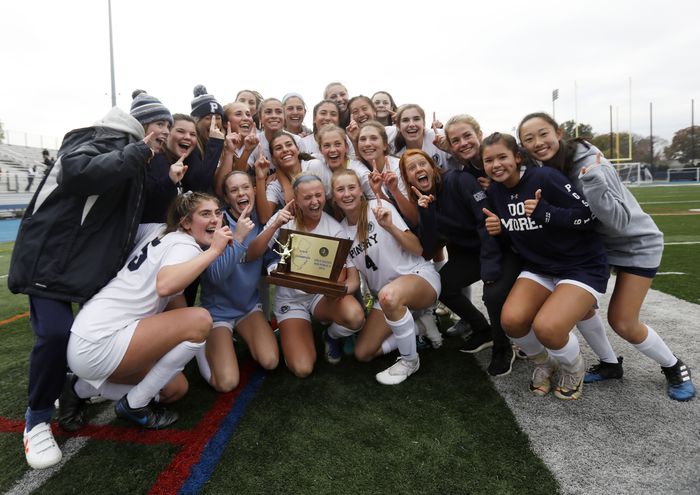
Dec 9, 2019 | School News
By Dean Koenig (V)
The boys’ and girls’ varsity soccer teams both had unforgettable seasons this fall, adding to the historical success of both programs.
The girls, coached by Head Coach Lauren Molinaro, topped off their great season by clinching the NJSIAA Non-Public “A” State Tournament trophy.
The girls had a week to recover from a disappointing loss against Ridge High School in the Somerset County Tournament before their first state tournament game against Bishop Eustace. Team captain Leah Mangold (VI) described the state tournament as, “a clean slate, a chance to prove ourselves and make something special of our season.”
Since Pingry girls’ soccer also claimed the state title last season, the players were committed to upholding their reputation.
Mangold said that the team found its rhythm when the girls “started to find that perfect balance between having fun and also staying focused.” Proving Mangold’s words to be true, Pingry put on two dominant performances in the first two rounds of the tournament. Madi Pilla’s (VI) four goals in the sectional semifinal game gave her the record for most goals scored in a single season by a Pingry Girls’ Soccer player.
The closest of Pingry’s state tournament games came against Red Bank Catholic in the South Jersey sectional final. Behind two goals from Pilla and one from Mangold, Pingry won the match 3-1 and took home the NJSIAA Non-Public “A” South Jersey title.
The South Jersey final win matched up Big Blue with DePaul, the winner of the North Jersey section, for the state group final at Kean University. With goals from five different players, Big Blue proved to be the best team in the NJSIAA Non-Public A group, defeating DePaul by a score of 6-0.
Reflecting on the season, Liv Volpe (V) said, “It was almost like déjà vu of last year. We had high expectations going in, some of which were disappointed, but we peaked at the right time and were able to finish on the highest note possible.”
Complementing the girls’ incredible season, the boys’ team made a run of its own in the NJSIAA North Jersey Non-Public “A” Tournament under Head Coach Miller Bugliari. Just as the girls did, the boys started the tournament strong, defeating Bergen Catholic 4-2 with two goals from captain Will Bugliari (VI). The boys were then faced with perhaps the toughest challenge of their season: Delbarton. Big Blue was able to hold Delbarton, one of the nation’s top high school teams, scoreless the entire game, winning 1-0 off of Aidan Gaynor’s (V) goal late in the game.
Speaking on this triumph, Gaynor said, “It was hands down one of the best moments in my Pingry career … so many people came out to watch, which was awesome for an away game, and it definitely won’t be forgotten by any of the players.”
The team went on to lose 5-3 in the final round to Seton Hall Prep, a team that had previously only let up three total goals the entire season.
Both the boys’ and girls’ seasons were nothing short of amazing, and neither the players nor the fans will forget the excitement and thrill of each game.
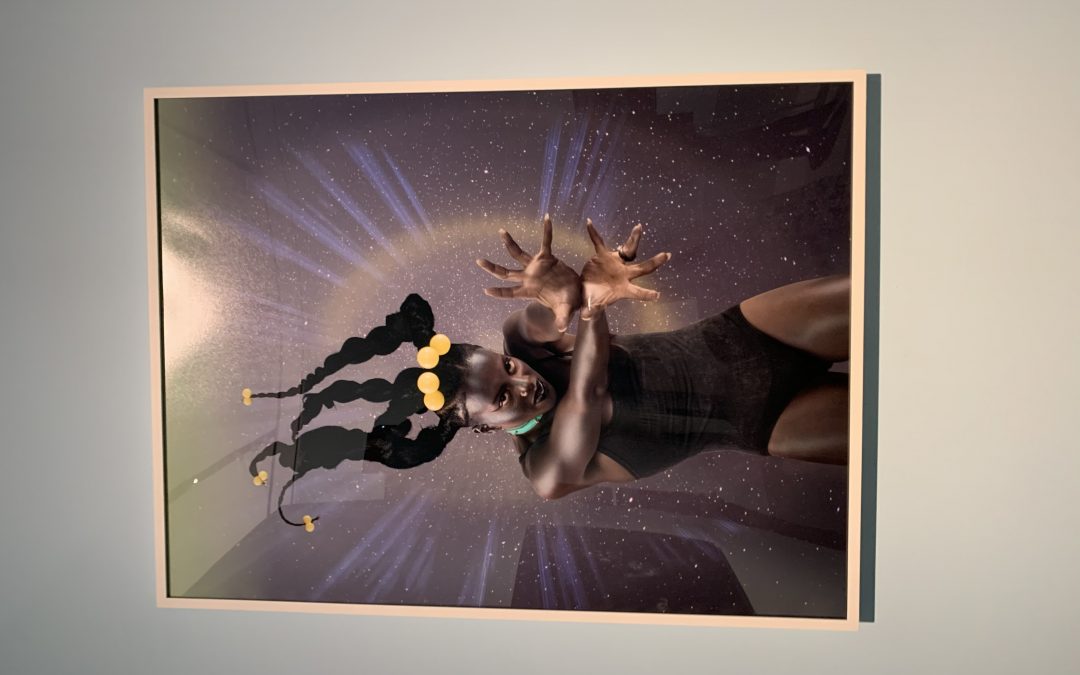
Dec 9, 2019 | School News
By Sydney Stovall (V)
On November 5th, a handful of students and faculty embarked on a trip to New York City to observe and discuss art exhibits that explored themes relating to Afrofuturism as part of their Humanities Independent Research Team (HIRT). The term “Afrofuturism” is fluid; it is completely personalized. There is no singular definition of Afrofuturism, but Ingrid LaFleur, a curator and self-proclaimed Afrofuturist, defines it as “a way of imagining possible futures through a black cultural lens.” Afrofuturism explores the intersection of black oppression and black empowerment through different mediums, including visual art, music, podcasts, and literature. The members of this HIRT have been working on creating their own definition of Afrofuturism through the exploration of these mediums. A field trip to New York City, a center for diverse art and thought, provided members the opportunity to do so.
After an hour long car ride filled with music like Janelle Monae’s Afrofuturistic ArchAndroid and Dirty Computer, the group arrived at its first exhibit: Kenyan artist Wangechi Mutu’s collection the NewOnes, will free Us. Located on the facade of The Met, Mutu’s installation encapsulates the essence of Afrofuturism by incorporating traditional African cultural symbols with elements that highlight an oppressive past and an empowering future. Mutu plays on the historical significance of caryatids, a style often used in Greek architecture that utilizes the female body as pillars to support the building. Rather than objectify her women to fulfill the sole purpose of supporting some greater entity, Mutu has her women placed on a pedestal in powerful poses, indicating a newfound superiority.
The final stop on the agenda was the “Utopian Imagination” exhibit located in the Ford Center for Social Justice. Works titled Cloud 9, Android Girl, Sky Lark, and Nubian Return intrigued the students as they walked in. Each work depicted a unique interpretation of a hopeful future. Gabrielle Billington (VI) was specifically moved by Lola Flash’s SYZYGY, which showed a queer black woman in an orange prison jumpsuit with unlocked handcuffs and an astronaut’s helmet. “With mass incarceration being an enormous issue within the black community, particularly in America,” Billington notes, “the photo was clear in breaking the stereotypes with a woman, uncuffed looking towards space and inferably, the future.”
Sydney Tindall (VI) was struck by how pieces “not only exhibited works that portrayed African Americans as powerful images, but [also how] they incorporated religions and other minority groups that have been discriminated against in the past and placed them in these futuristic settings as if to say ‘here we are, not only present, but thriving and saving the world.’” Although Afrofuturism focuses on the African diasporic identity, the themes of hope for the future, despite an oppressive history, applies to all systematically marginalized voices, regardless of race.
This trip truly exemplifies the power art has to convey a message without an explanation. Perhaps this is why artwork and Afrofuturism coalesce so seamlessly together. They both serve as platforms to allow individuals to share their ideas, their criticisms, and their hopes.
Dec 9, 2019 | School News
By Zara Jacob (V)
Each year, The Far Brook School hosts the Widening the Lens Conference, a space for independent schools in New Jersey to come together and discuss diversity and inclusion. Each school is expected to send one or two representatives from different constituencies of the school, including administrators, trustees, parents, students, diversity and inclusion practitioners, faculty, and alumni.
This year the conference was titled “Class in the Classroom: Exploring Socioeconomic Diversity in Our Schools,” with keynote speaker Anthony Jack, a junior fellow at the Harvard Society of Fellows and assistant professor of Education at the Harvard Graduate School of Education. The conference started with a speech by Dr. Jack, author of Privileged Poor: How Elite Colleges are Failing Disadvantaged Students, who discussed how, despite the fact that many elite colleges and private schools are making an effort to provide access to students with varying socioeconomic statuses, there is little to no action to cultivate a sense of inclusion. “Access and Inclusion,” he repeats; that is what elite colleges and independent high schools must aspire to reach in regards to the maintenance of socioeconomic diversity.
The second part of the conference saw the group split into “pods”: students met with students, teachers met with teachers, and so on. In the discussion among students, topics ranged from stories of being bullied for relying on financial aid, to the impending burden of college tuition, to not being able to afford class symbols like Airpods or a Canada Goose jacket. However, one student from an all-boys school in Jersey City opted out of speaking on the panel, saying that he did not have anything to talk about: “My school actually does a pretty good job.” He went on to talk about the incorporation of legitimate diversity-building implementations at this school, and how it fostered an environment for socioeconomic diversity to be candidly discussed and subsequently addressed. The student panel was arguably the prevailing aspect of the conference, as Mr. Levinson notes “I think it made an impact on everybody, but in particular the adults at Pingry; it got everyone thinking. Those personal stories are what people remember. When you hear actual voices of students, you think about what we can do or continue to do to improve the student experience, while also considering all the different layers involved.”
The conference concluded with each pod of students, faculty, and administrators coming together to talk about takeaways from the conference and how this discussion could be brought back to their respective schools. Pingry’s pod included Mrs. Ostrowsky, Ms. López, Mr. Levinson, myself, and other board members, alumni, faculty, and parents. The primary focus of the meeting was to brainstorm a tangible, realistic plan to engage discussions about socioeconomic diversity and possible solutions to further facilitate the aspect of “inclusion” at Pingry.
For tuition-based schools like Pingry, socioeconomic diversity can be a tricky subject. No one wants to talk about money, which in and of itself is a luxury and an indication of how we deal with socioeconomic diversity at independent schools. Pingry’s attendance at the Widening the Lens Conference was undoubtedly a necessary and powerful stepping stone for the cultivation of a community that is aware and active in regards to socioeconomic diversity. But this should not be all that is done. If you, or anyone you know, wants to help create a plan that enables the growth of socioeconomic diversity at Pingry, please talk to Mrs. Ostrowsky, Ms. Lopez, or myself. It is our responsibility to do more than just talk about socioeconomic diversity; action is pressing and necessary.

Dec 9, 2019 | School News
By Martine Bigos (IV)
On October 21st, Pingry’s Middle and Upper School students attended an assembly where guest speaker Sean Swarmer shared his inspiring life journey. Sean has survived cancer twice and is the first cancer survivor to climb the highest mountains on each continent (with only one fully-functional lung). In addition, he has completed the Hawaii Ironman Triathlon.
Sean’s battle with cancer began when he was just thirteen years old. Diagnosed with stage 4 Hodgkin’s Lymphoma, Sean was told that he only had three months to live. Intense chemotherapy resulted in weight gain and hair loss. Life seemed grim, but Sean had two choices: he could either give up, or choose to fight for his life. He chose the latter.
“I could either fight for my life or give up and die,” he says. “I wasn’t focused on ‘not dying.’ I focused on living.” Keeping a positive mindset during his battle, he survived.
However, the fight was not over. Three years later, doctors discovered a second cancer known as an Askin’s tumor and informed Sean that he had only fourteen days to live. The thought of having a two weeks’ notice on your life sounded like too much to bear, but Sean knew that once again he had the choice to keep moving with a positive mindset or to give in to cancer. Though one of his lungs lost its function due to radiation treatment, Sean survived.
Sean then set out on a new adventure. He wanted to become the first cancer survivor to summit Mt. Everest. Through intense training, Sean prepared himself for the climb and succeeded. Carrying a flag signed by cancer patients up to the summit, he climbed the mountain for them.
While in Nepal, Sean visited a cancer hospital where, on average, ninety-five percent of the patients pass away. Sean gave one patient his lucky green t-shirt that had carried him through countless treatments and told the patient to pass it on to another patient once they recover. According to Sean, all patients in the hospital who have worn the t-shirt have survived, a miracle ostensibly caused by the boost in confidence it inspires.
In addition to climbing Mt. Everest, Sean has summited Mt. Aconcagua, Kilimanjaro, Denali, Elbrus, Vinson, and Puncak Jaya.
Mrs. Marotto, the chair of the Health Department, coordinated the assembly along with Dr. Rosen and said that “the theme for this year’s strategic plan is student wellness. Dr. Rosen and I thought Sean’s inspirational message of resilience and accomplishment in the face of a life-threatening cancer diagnosis was valuable for our community to hear. There are so many life lessons to be learned from someone like Sean, and we hope our community was inspired by his story and his courage.”
Sean taught the Pingry community a lot of lessons, the most important of which was to choose to fight rather than to give up.
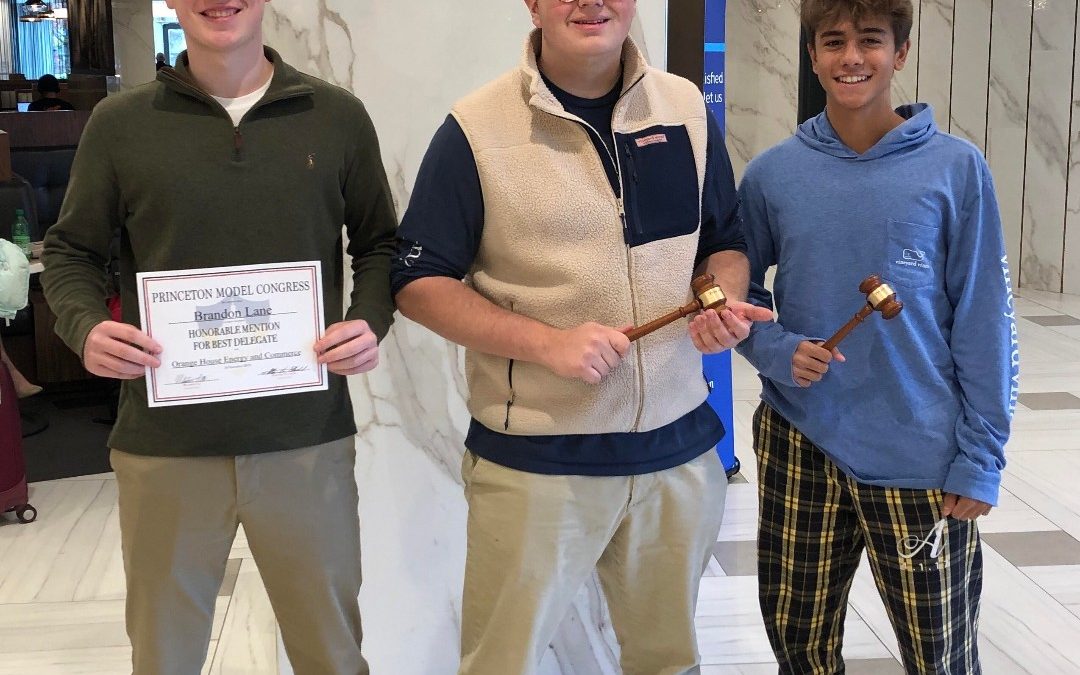
Dec 9, 2019 | School News
By Brooke Pan (V)
The weekend before Thanksgiving Break, Pingry students embarked on a trip to the nation’s capital to participate in the Princeton Model Congress. At ten o’clock, the bus left the Pingry campus to start its journey to the prestigious conference. There, in order to simulate the dynamics of a Congress, students prepared bills and presented them to a group of students, engaging in discussions and working on amendments until it came time to put each bill to a vote. If the bill passed within its committees, students then had a chance to present their bill in front of a larger group of students, known as a full committee.
The club’s leaders, Lily Schiffman (VI) and Thomas Beacham (VI), were interviewed and asked what attracted them to Model Congress in the first place. Schiffman answered, “Model Congress is and always has been another way for my voice to be heard on issues that I’m really passionate about.” Beacham added, “In my freshman year, [Model Congress] seemed like some vague interesting field about the government. … However, Model Congress really stuck to me and that’s why I’ve been really steady with it.”
When the bus arrived at the Washington Hilton Hotel, Pingry students, along with advisors Dr. Jones and Dr. Johnson, made their way to their assigned rooms to relax before the opening ceremony. After resting, the students and faculty gathered in a ballroom with students from schools all over the country. The opening ceremony started off with introductory speeches, though the primary goal of the ceremony was to elect a president to represent the entire body. Three candidates made speeches stating why they would be the best fit for office, and later, answered questions on their opinions and plans regarding certain subjects. When reflecting on her experience at the opening ceremony, Zara Jacob (V) stated that “it was both very exciting and inspiring to be modeling a version of what it could be like to take part in the government today.”
Over the course of the next few days, students mirrored practices of delegates in the legislative branch by debating and amending bills until an agreement was reached. Beacham noted, “I personally really love being in small committee and getting to know people’s ideas and debating them and trying to figure out how things work and the best way to make things work.”
On Sunday, the students participated in their last full committees, where they wrapped up voting on the remaining bills. After the closing ceremony, Pingry students got back on the bus to return to campus.
In reflecting on her first experience at a Model Congress conference, newcomer Sophie Pollard (V) stated, “At such an important point in our government’s history right now, it’s cool to be participating in something like Model Congress where you understand the process of what’s going on and the role that the government’s playing … When the events that are taking place are so significant, modeling congress just feels like a really cool and great thing to do.”
Dec 9, 2019 | School News
By Martine Bigos (IV)
On Sunday, November 10, Pingry Taiko Drumming attended Columbia University’s Fall Taiko Festival in Manhattan. The drummers performed “Dokokara” and “Matsuri” and they enjoyed the performances of many talented groups, including Swarthmore, Cornell, and Stony Brook Taiko. Noah Bergam (V) represented Pingry in the group performance of “Tonbane” at the end of the festival. Noah said that the performance “made me realize that our Taiko group doesn’t exist in a vacuum. There are so many nuanced styles and group dynamics––it was awesome to see it all coalesce on stage and form a community of drummers.” Belinda Poh (IV), another member of the club, added, “It was a really cool experience to see how many different people played and the different ways to play. I think it was worth it and all in all a really interesting and fun thing to do. Performing was fun, but watching the other groups I think was the best part.”
Mr. Leone, Pingry’s Taiko Club leader, was interviewed shortly after the festival, and below are excerpts of that conversation:
How did you learn about the festival?
I performed at the Columbia Fall Taiko Festival last year as a member of New York Taiko Aiko Kai (NYTAK). One of NYTAK’s performing members and Columbia Taiko’s president, Koh Yamakawa, was in charge of running the festival last year, and after learning that I advised a taiko group at Pingry, he was eager to have us perform at this year’s festival.
What was your favorite performance to watch?
I’m always in awe of any performance of Jack Bazaar (performed by Swarthmore Taiko at the festival). Kris Bergstrom, the composer of the piece and lead instructor at the Los Angeles Taiko Institute, is a pioneer of naname (slant drum) style choreography, and looks for ways to push and challenge the boundaries of how to play taiko. He ran a workshop at the East Coast Taiko Conference a few years back, and we spent the full two-and-a-half hour workshop just learning the first six measures of the piece (a section titled “Cronkite”). While the rhythms aren’t necessarily difficult, the movement is incredibly challenging, so it’s something special to see the piece be performed.
Are there any pieces that you would like to bring to Pingry that you saw at the festival?
I’m thinking of bringing in Omiyage (performed by Taiko Tides at the festival, composed by Shoji Kameda) as one of next year’s performance pieces. The rhythms and choreography are a little tricky, but it is a fun and satisfying piece to play. It’s also one of the pieces that inspired me when I first started playing taiko, so it would be special for me to get to teach and have our students perform it. I’m hoping to get a couple of student-written pieces worked in to our repertoire. Getting to see other groups play, each with their different styles, opens the door for what is possible rhythmically and choreographically, so I’d like to channel that into helping our group write a few pieces of our own to help us define our own Pingry Taiko style.










